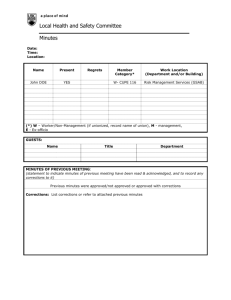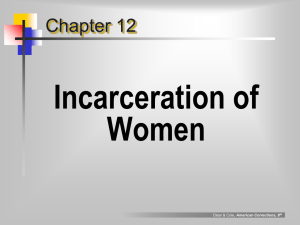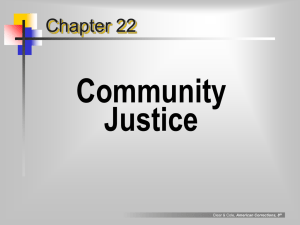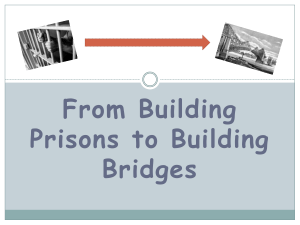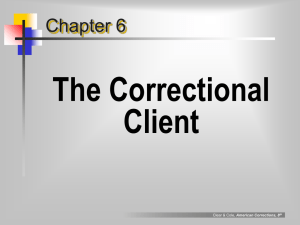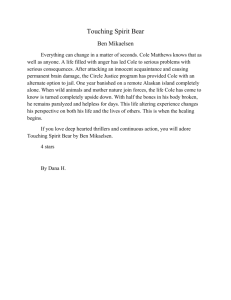Pennsylvania system
advertisement
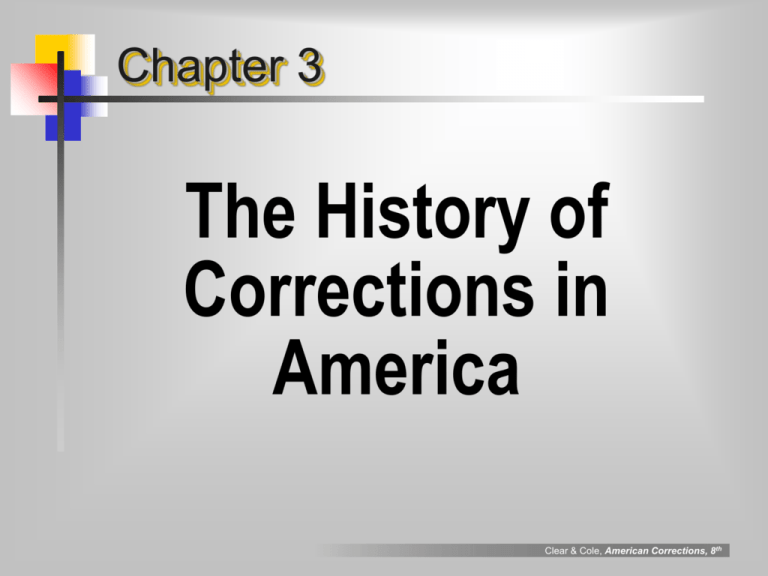
Chapter 3 The History of Corrections in America Clear & Cole, American Corrections, 8th The History of Corrections The The Colonial Period Arrival of the Penitentiary The Pennsylvania System The New York ( Auburn ) System Debating the Systems Development West or Prisons in the South and Southern Penology Western Penology Cincinnati, 1870 Elmira Reformatory Lasting Reforms The Reformatory Movement Clear & Cole, American Corrections, 8th The History of Corrections Cont. The Rise of the Progressives Individualized Treatment and the Positivist School Progressive Reforms The Rise of the Medical Model From Medical Model to Community Model The Crime Control Model: The Pendulum Swings Again The Decline of Rehabilitation The Emergence of Crime Control Clear & Cole, American Corrections, 8th Evolution of punishment in America, 1600 – 2000 Flow Chart Medical Model 1930s - 1960s Community Model 1960s - 1970s Crime Control Model 1970s - 2000 Progressive Period Colonial Period 1890s - 1930s 1600s - 1790s Reformatory Movement Prisons in South & West Arrival of the Penitentiary 1870s - 1890s 1800’s 1790s - 1860s Clear & Cole, American Corrections, 8th William Penn William Penn (1644–1718) English Quaker who arrived in Philadelphia in 1682. Succeeded in getting Pennsylvania to adopt “The Great Law” emphasizing hard labor in a house of correction as punishment for most crimes Clear & Cole, American Corrections, 8th “Penitentiary” an institution intended to isolate prisoners from society and from one another so that they could reflect on their past misdeeds, repent, and thus undergo reformation. Clear & Cole, American Corrections, 8th Benjamin Rush Benjamin Rush (1745–1813) Physician, patriot, signer of the Declaration of Independence, and social reformer, Rush advocated the penitentiary as replacement for capital and corporal punishment. Clear & Cole, American Corrections, 8th principles of the “penitentiary” isolate prisoner from bad influences of society - liquor, temptation, people penance & silent contemplation productive labor reform (thinking & work habits) return to society, renewed key = solitary confinement isolate from contagion foster quiet reflection punishment, since man is social animal cheap shorter sentence, fewer guards Clear & Cole, American Corrections, 8th “Separate Confinement” A penitentiary system developed in Pennsylvania in which each inmate was held in isolation from other inmates, with all activities, including craft work, carried on in the cells. Clear & Cole, American Corrections, 8th competing models Pennsylvania system “Separate system” solitary confinement eat, sleep, work in cell religious instruction reflection upon crimes reform through model for Europe e.g. salvation religious enlightenment Walnut St. Jail Western Penitentiary Eastern State Pen. Clear & Cole, American Corrections, 8th competing models Pennsylvania system “Separate system” solitary confinement eat, sleep, work in cell religious instruction reflection upon crimes New York system reform through salvation religious enlightenment model for Europe e.g. Walnut St. Jail Western Penitentiary Eastern State Pen. evolved into “Congregate system” hard labor in shops-day solitary confinement-night strict discipline rule of silence reform through model for US-economical e.g., Auburn Prison, 1816 good work habits discipline Clear & Cole, American Corrections, 8th and the winner is…? Pennsylvania/Philadelphia model Europeans applauded and replicated New York/Auburn model won out in US; more cost-effective labor; state negotiated contracts with manufacturers but neither curbed crime nor reformed offr’s various reforms tinkered w/ look, purpose but icon of high-walled fortress remained: Attica, Quentin, Folsom, Sing Sing Clear & Cole, American Corrections, 8th Southern penology Devastation of war and economic hardship produced 2 results: Lease system Private business negotiated with state for labor & care of inmates--Kentucky (1825) Penal farms State-run plantations which grew crops To feed inmates To sell on free market Clear & Cole, American Corrections, 8th Western developments penology in west not greatly influenced by the ideologies of the east prior to statehood, prisoners held in territorial facilities or in federal military posts and prisons 1852: San Quentin - California’s 1st prison 1877: Salem, Oregon prison - Auburn model western states discontinued use of lease system as states entered into the union e.g. Oregon, California, Montana, Wyoming Clear & Cole, American Corrections, 8th the Reformatory Movement (1870s - 1890s) product of disillusionment with oppressive penitentiary system focus remained inmate change! key features: indeterminate sentences > fixed offender classification should be based on character & institutional behavior use early release as incentive to reform Clear & Cole, American Corrections, 8th Hallmarks of the reformatory movement National Prison Association precursor: American Correctional strong religious influence (still) Cincinnati Asso. meeting,1870 Declaration of Principles “reformation is a work of time: and a benevolent regard to the good of the criminal himself, as well as to the protection of society, requires that his sentence be long enough for the reformatory process to take effect.” e.g., Machonochie, Crofton, Brockway Clear & Cole, American Corrections, 8th “Reformatory” an institution for young offenders emphasizing training, a mark system of classification, indeterminate sentences, and parole Clear & Cole, American Corrections, 8th “mark system” a system for calculating when an offender will be released from custody, based on both the crime & his behavior in prison devised by Alexander Maconochie (England), at Norfolk Island penal settlement (off Australia, 1840) at sentencing, offender is ‘given’ a number of “marks,” based on offense severity (a “debt” to society, to be “paid” off) for release, offender must earn marks via voluntary labor participation in educational, religious programs good behavior adopted in Ireland, never England Clear & Cole, American Corrections, 8th the Irish system developed by Sir Walter Crofton derived from Maconochie’s mark system four-stage program of graduated release, based on offender performance all sentences served in four stages; move “up” w/ accumulation of marks 1. solitary confinement - all start here 2. public works prison - begin earning marks 3. intermediate stage - (like half-way house) after earning enough marks 4. ticket of leave - conditional release = precursor of modern parole Clear & Cole, American Corrections, 8th “reformatory” Zebulon Brockway an institution for young offenders emphasizing training, a mark system of classification, indeterminate sentences, and parole: 1st time felons (16-30) diagnosis, individualized treatment, reform operation: intake interview: determine causes of crime individualized work & education program mark system of classification (work, school, behavior). move up OR down, with accumulation of marks: • begin at grade 2 • can earn 9 marks/mo. for 6 months: • grade 1; or • grade 3; • then, 3 mo. good behavior: grade 2 again. administrators determine release date Elmira Reformatory (Zebulon Brockway; 1876-1900) Clear & Cole, American Corrections, 8th Reformatory movement ends failed to reform (like penitentiary) brutality corruption not administered as planned but, important features survived: inmate classification rehabilitation programs indeterminate sentences parole Clear & Cole, American Corrections, 8th the Progressive Era (1890s - 1930s) age of reform: set tone for American social thought & political action until 1960s! condemned ills of new urban society--big business, big industry, urban blight faith in science to find answers to crime, criminal behavior, treatment new faith in government action to eliminate social problems--slums, crime trends of period industrialization urbanization technological change scientific advancement Clear & Cole, American Corrections, 8th the “Progressives” socially conscious, politically active, mostly upper-class reformers of early 1900s attacked excesses of emergent 20th century - big business, industry, urban society believed science (positivism) + state intervention could/should solve social & political problems advocated “treatment according to the needs of the offender,” not “punishment according to severity of the crime” subscribed to “positivism” Clear & Cole, American Corrections, 8th “positivist school” an approach to criminology and other social sciences based on the assumption that human behavior is a product of biological, economic, psychological, and social factors, and that the scientific method can be applied to ascertain the causes of individual behavior subscribed to by Progressives Clear & Cole, American Corrections, 8th principles of Positivist School behavior (including crime) is NOT the product of free will. behavior stems from factors beyond control of the individual criminals can be treated so they can lead crime-free lives. treatment must focus on the individual & his/her problem(s). Clear & Cole, American Corrections, 8th “progressive” reforms 2 strategies for CJ reform: improve general social, economic conditions that seem to breed crime rehabilitate individual offenders 4 planks in “progressive” platform: probation (John Augustus, 1841) indeterminate sentencing (by 1920s, 37 states) parole (by 1920s, 44 states; 80% of releases) juvenile courts (1899, Cook County) By 1970s, most of these enlightened & wellmeaning reforms seen as having failed to live up to their promise Clear & Cole, American Corrections, 8th The Medical Model (1930s - 1960s) a model of corrections positing that criminal behavior is caused by social, psychological, biological deficiencies that require medical treatment first serious efforts to implement truly medical strategies aimed at scientifically classifying, treating, rehabilitating criminal offenders e.g. “medical” programs & institutions psychology (Karl Menninger) Maryland Patuxent Institution, 1955 sexual psychopath, sociopath laws crime as sickness Clear & Cole, American Corrections, 8th The Community Model (1960s - 1970s) model of corrections positing goal of CJS: to reintegrate offender into community key features prisons should be avoided; prison = artificial environment; prison frustrates crime-free lifestyle need to focus on offender’s adjustment into society; not just on psychological treatment probation intermediate sanctions; (alternatives to incarceration) parole Clear & Cole, American Corrections, 8th The Crime Control Model (1970s - 2000) less ambitious, less optimistic, less forgiving view of man & ability of CJS to change him crime better controlled by more incarceration & strict supervision precipitating factors public concern over rising crime in ‘60s disillusionment with treatment public clamor for longer sentences distrust of broad discretion given to correctional & parole authorities Clear & Cole, American Corrections, 8th
